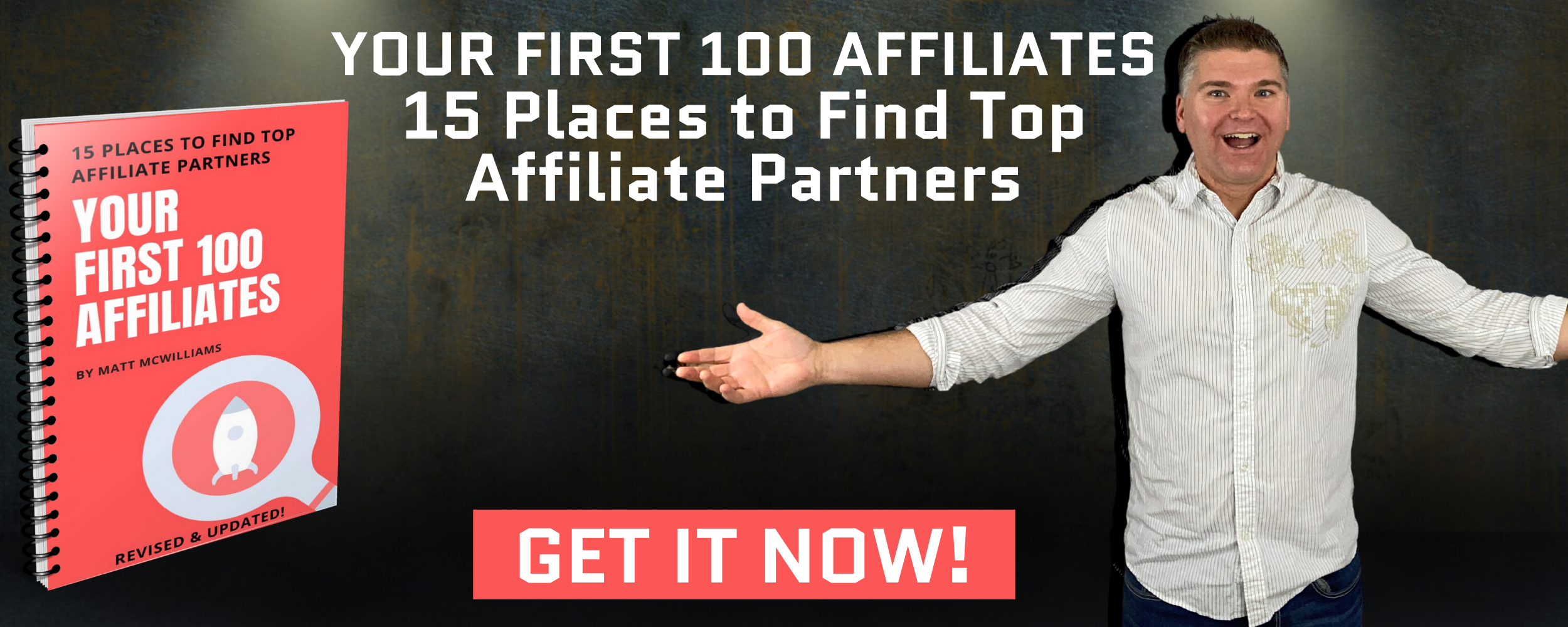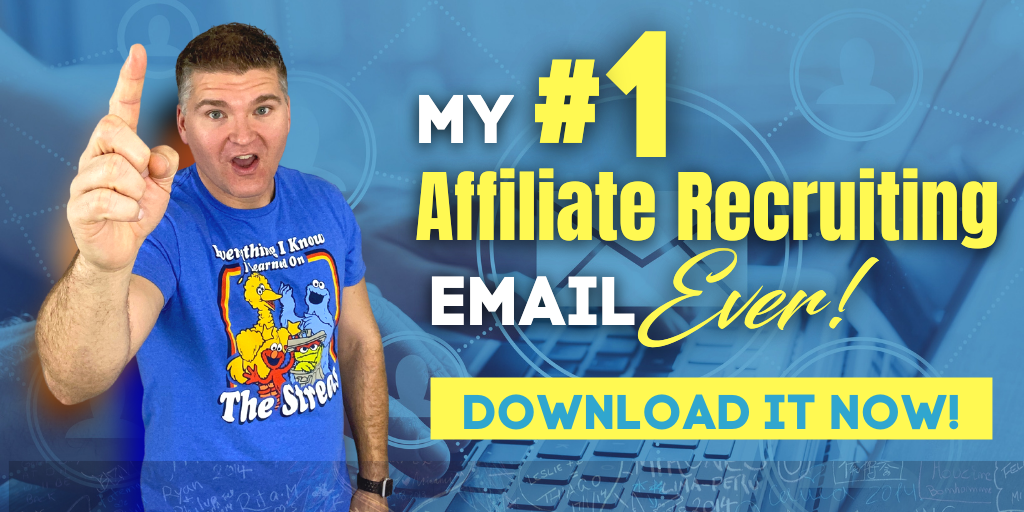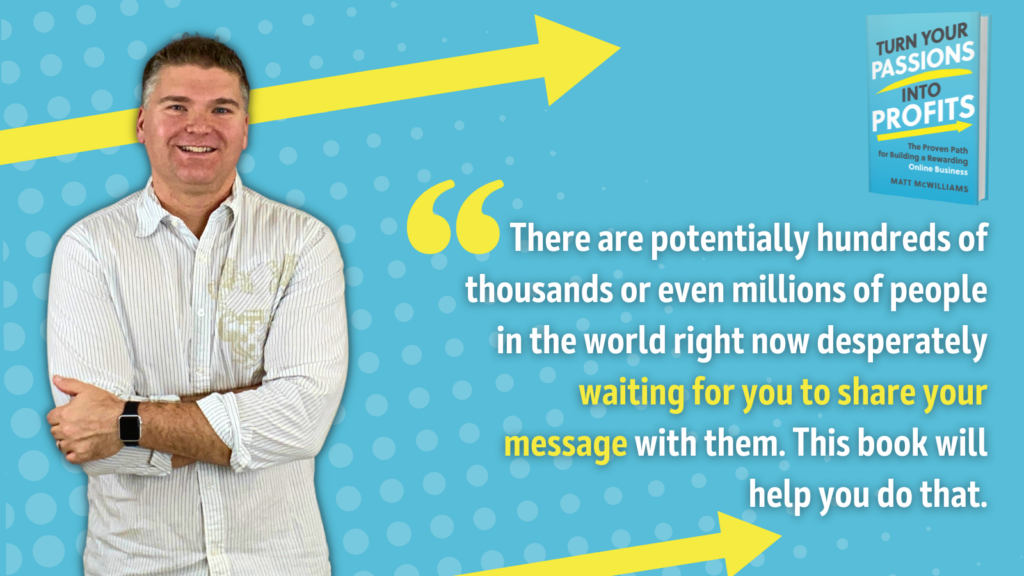Promoting evergreen affiliate offers can be a challenge because there is no urgency. When a product is available 24/7, 365 it can sometimes be hard for affiliates to put together a solid promotion plan and really get people excited. Today, I shared exactly how we did than in one of our evergreen promotions and how you can build excitement, buzz, and even urgency in your evergreen promotions.
Click Here for The Written Transcript of This Episode
If you are ready to take your business to the next level and start an affiliate program, start with my free report, Your First 100 Affiliates. This report takes nearly two decades of experience, trial and error, and lessons learned about finding top affiliates in nearly every conceivable niche and puts them all into one report. Grab your copy here!
LINKS MENTIONED IN THIS EPISODE
What’s Working on Social Media Right Now with Jeff Bullas
Text me at 260-217-4619
Don’t Miss An Episode – Subscribe Below
Previous Episodes of The Affiliate Guy
How to Build Strong Relationships with Your Affiliates
10 Lessons I Learned Launching a Bestselling Book
Listener Q&A: Finding Affiliates, What’s Working in Affiliate Recruiting, Email Templates, and More
How to Promote An Evergreen Affiliate Offer In Just ONE Week
Promoting Evergreen affiliate offers can be a challenge because there’s no urgency. When a product is available 24/7-365. It can sometimes be hard for affiliates to put together a solid promotion plan and really get people excited.
So today I’m sharing exactly how we did that in one of our Evergreen promotions recently, and how you can build excitement, buzz, and even urgency into your Evergreen affiliate promotions. So the good part of an Evergreen affiliate promotion, it’s available 24/7-365, right? These are most products.
The good part about them is they’re always available. You can do things like promote it on your resources page. You can do things like promote it on your podcast, and if somebody listens to it a year from now, it’s not a big deal.
You can promote it on YouTube and it’s going to be there when somebody watches that video 17 months from now. It allows you to put it into your autoresponder and things like that. That’s the good thing about an Evergreen affiliate promotion.
The other good thing is you can decide at any moment to do a hard push for something like that. You can do a promotion, a week long promotion or a five day promotion or whatever. And this week we’re talking about a week long promotion, just as an example.
But the problem with Evergreen is that it’s always available. It’s available 24/7-365 and so there’s no urgency, there’s no deadline. And so I want to talk today about the solution to that.
And the solution ultimately to that is to promote in a confined period of time. And so today I’m going to show you how to do that. I’m going to share some tips on how to do that today.
This was actually a lesson that we did for our Insiders club a couple of years ago, but we wanted to open up to the public. I had Robby Miles come on and we talked about a promotion that we were in the midst of. And this is something where we took a deep dive into how we promoted it.
And I share how you can apply these principles to your Evergreen affiliate promotions. And actually, how do we do an Evergreen affiliate promotion in a confined period of time? So how do we create that launch like atmosphere, those positive to launches where there’s momentum and there’s all these things and there’s a deadline, there’s urgency?
How do we apply that to an Evergreen promo? That’s what we’re talking about today. Now, I want to say if you’re an affiliate manager, you’re going, this is it for me, this is for affiliates.
I’m running an affiliate program. I’m not going to promote anything as an affiliate. Well, listen up.
And share this with your affiliates. If you have an Evergreen program, share this episode with your affiliates. All right?
So make sure you do that. Don’t just dismiss this because it’s not for you. So listen up.
I’m going to share today how to do an affiliate promotion, an Evergreen affiliate promotion in about a week’s time frame. I’m joined again by Robby Miles, and we are going to talk today about how to promote an Evergreen product, but in a defined period of time, specifically about a week. And this is all coming about because that’s exactly what we’re in the process of doing now.
We are promoting a product that’s available 24/7-365, and we’re promoting it in a one-week period. So we’re treating it kind of like a launch. And I’ve got six strategies for you today to help you to do that.
Matt: So. Robby, Welcome, my friend.
Robby: Yeah, this is awesome. This is a promo we’ve been looking forward to for a while, and now we get to actually pull it off.
Matt: Yeah. So for those of you who don’t know, we’re recording this in early August 2021. And this is a promo that was supposed to have happened last week, but about two weeks before that, I went through about with COVID and it laid me out for a few weeks. And just now getting back to things.
So we’re re-planing this launch. You kind of get to be a part of us planning this launch as we think through. What are the things that we need to do what are the six things that we need to do to make sure that this promotion is a success?
And so I’m going to be looking at my notes here. These are the notes that we’re going to use kind of as we think through this promotion. And so the first thing, which we already did, is you need to pick a seven day period.
An eight-day period could be a 6 to 9, 10 day period to promote. In our case, we picked an exact one week period to promote. Now, we ended up having to move it, and that happens sometimes.
I think we had to move it back, what, two weeks, three weeks, Robbie, which you’ll see part of the strategy, why we had to move it when we get to number two. But that’s the first thing, is pick a week and pick ten days, nine days, whatever it is. Pick a start date.
Get my #1 affiliate recruiting email (the one I’ve personally used to recruit thousands of affiliates in dozens of niches). Grab your copy here!
Pick an end date. Now, if your product is a product that your audience is very dependent upon, they’re very sensitive to money, they’re employed full time, typically, they’re not entrepreneurs, then this is a product where you probably want to finish on a Friday. Because we studied it, we know that 42%, at least in America, 42% of the population is paid on any given Friday.
So 42% of your potential audience, if they’re full-time employees, they’re like the typical American. They don’t have $5,000 just lying around, thousands of dollars lying around. They’re getting paid on that Friday, and that’s a big deal from them from a cash flow standpoint.
And we all know the stories like, don’t go to the bank at 05:00 on a Friday. We make that mistake. We’re entrepreneurs.
We can go to the bank anytime we want. And anytime we inevitably go on a Friday, my wife’s like the line is 45 minutes long just to deposit our whatever check we got from a client. And it’s like, I’m turning around, I’m coming home.
I’ll just do this Tuesday afternoon or something because we forget. But that’s the rhythm. And so talk about it with the merchant, talk about it with the affiliate manager.
What is the best day for this thing to end? Do they find better success on Fridays? Do they find better success on Sundays or Tuesdays or whatever?
If your audience is less sensitive to cash flow, Thursday works great. If your audience is entrepreneurs, Tuesdays, Wednesdays, and Thursdays work great. But talk to them and also use your own experience to find that start date and then back up from there.
So with our promotion, I forget off the top of my head what day of the week we’re closing, but we picked the day that we’re closing and then we just backed it up. Actually, I think it is a Friday because we’re promoting Thursday through Friday, which leads into number two here in a second. But just pick that time and then back it up.
So for us, one of the key things was number two, which is with an evergreen promote, just like a launch, you want to warm up your audience. And so for us, part of that warm-up was making sure that we interviewed Joe Fier, who’s the if you read last month’s ATM report, then you should go back and read that. By the way, it’s all about monetizing a podcast.
You got introduced to Joe. But we wanted to interview Joe about how to start and scale and monetize a podcast. Well, we only do our live lessons.
We do those on Thursdays. When you’re watching this, you probably have noticed we haven’t done one in a while again, because I was sick. But we do those on Thursday.
So for us, that was one of the defining factors, was we’re going to start this warm up on this Thursday. So that looks like Thursday we do the Live, Saturday we mail to the replay.
And so those are kind of the baked in times there. So for us, that means the promotion starts on Sunday. We’ve introduced.
We’ll probably figure out, I don’t know what we’ve got planning for Friday, but we’ll probably figure out something along the lines of helping to warm up the audience. We’ve already technically started with the ATM report for you guys, but that’s what you want to do there, is you want to warm up your audience and I want to share some ways that you can do that. First of all, just make sure that you’re engaging your audience.
If you’re like, I’m going to do this big promo for this Evergreen product in two weeks. But for the next two weeks, you’re not keeping your audience engaged. Just in general.
That’s not good. You cannot come out this cold, Robby, I know you have some experience kind of coming in cold to some promos and it’s hard.
Robby: I’ve done this a couple of times with my own personal list.
I’ve let it go dry and then I’ll come back and it’s like we did a promotion with Alan Thomas. He’s like, ‘Hey, let’s do this, we can do it next week. ‘
And I was like, I haven’t emailed my list in like two months. I need to email them first and just get them thinking, first of all, that I exist again, and then second of all, that I’m leading them toward what his offer was finally going to be. And for me, that offer was to join the webinar.
But I had to start framing that at least two, or three weeks early and get them familiar with the rhythm again. And then the promotion, we got people in the door, got people to the webinar, and then Alan took it from there. And again, an Evergreen-type offer.
I’ve done the same with different review posts and stuff that I’ve mailed to where it’s like, well, let’s lead up to this reasons why you might be interested in this topic and then release the review post. So there’s a couple of different angles there that to use to warm up.
Matt: Yeah. So if you haven’t if you’re not keeping your audience engaged, if you are keeping your audience engaged, well, then just keep doing what you’re doing. Lean into more of the next six that I’m going to share to warm up your audience. But if you haven’t been like Robby just said, you just got to remind them again and reintroduce yourself.
Just give them valuable content with no financial call to action. Nothing to do on their part other than to read the content or listen to the content or watch the content.
You just want to pour in, build up some of that reciprocity. So make sure you’re engaging your audience. Start to ramp that up.
Maybe you consistently only do once a week. You’re going to go heavy as we’ll talk about in number three. So you need to ramp that up a little bit, starting a couple of weeks before the promo.
Maybe go send a second email that week or even a third, release a second and third piece of content and kind of bridge that. Okay, well, I normally just email once a week, and now I’m going to email six or seven times in a week. You want to bridge that with two or three.
The second way you can warm up your audience is just to mention people that you’re promoting. Mention the product, mention the concept, talk about just the concept in general. So in your case, Robby, you mentioned Alan Thomas, you’re promoting it’s a weight loss offer, and you’re tying that into productivity.
So you could be talking about fitness, talking about how fitness ties into productivity, talking about how studies show that if you’re a six foot tall man and you weigh 320 pounds, you are less productive than a six foot tall man who weighs 230 pounds. And tie that in, get your audience thinking about that.
Third thing you can do is to quote the person. So if you’re promoting something where there’s a face to the program, a face to the product, and most of the time there is in the digital world, whether it be a course or a membership, but even like, physical products. If I was going to promote my planner, my full focus planner created by Michael Hyatt. Ain’t no, Michael didn’t design the planner.
He didn’t whittle the tree down to the paper and create the product, but he’s the face of the company. So I would start quoting him about planners and productivity and get my audience thinking about it. The quotes don’t even have to be related to the topic.
If I were promoting Stu McLaren’s tribe course, I might just quote him one of his quotes. I actually quoted him in my book, in the chapter on Monetization. The more money you make, the more impact you can have.
What does that have to do with memberships? In theory? Literally nothing.
Now, I could certainly make it with that, but when you see that quote from Stu McLaren, the more money you make, the more impact you have. You don’t suddenly go, membership sites. You’re not even thinking about membership sites.
But I introduced you to Stu McLaren, and that’s important. You can link to content from the person. So just maybe linking to a blog post that they wrote or a podcast episode they did, or a Facebook post, a Facebook Live, a video they released, something like that, just linking to their content.
It could be linking to an article that they were mentioned in. So maybe they had a Forbes article written about them three months ago. And you link to that.
Well, you’re introducing your audience to the person and the topic and the concept, but you’re also kind of that Forbes article is like spreading some magic authority dust on them because you’re basically saying, hey, this Joe was in Forbes magazine, he must be legit, right? Fifth is just talking about the topic. We talked about this in the engaging thing, but just going more into that specific topic.
It could be as simple as promoting Joe. Well, the reason why we did the ATM report last month or this month. Yeah, this month, sorry.
The reason we did the 80 I wrote it last month. That’s why I was like, wait, the reason we released that to you guys this month was very specifically to get our AIM members thinking about podcasts and how they can start and scale and monetize a podcast. And so, of course, you guys are our top level, right?
You’re in our top 1% of our entire list. So we want you to be thinking about it first. And we’re creating demand with you to potentially want to buy Joe and Matt’s course all about podcasting and join their membership.
All about podcasting. So just getting you thinking about that, thinking about the topic of podcasting is important. Of course you can do that with your whole audience as well.
And we have been the 6th thing you can do is to find a student, to find a customer, somebody who’s purchased the product that you’re going to be promoting. Interview them. Like you may not be able to get Joe if you’re promoting Joe, you may not be able to get Joe or Matt.
I don’t know their schedule, right? Joe and Matt and I are really good friends. So I was like texting like, hey, let’s do a Facebook Live.
Cool, we’ll make it work. Boom, done. You may not be able to do that, so go find a student.
If there’s a Facebook group for students, if there’s a course directory, sometimes there’s like a student directory if it’s a product and there is no Facebook group, maybe go on Facebook and post to your friends and just say, any of my friends. I’m just going to make something up. The Switch Pod here, it’s like the thing we go back to any of my friends every time I know well because it’s always on my desk.
‘Any of my friends use the Switch Pod’ and a couple of them. ‘Yeah, I love it. ‘
‘Hey, can I hear you about how you love mine? ‘ Yeah, I know Robby, I think you got one right about the same time I did.
I remember we were at LaunchCon and we were like going around, we’ve got our Switch Pod. We’re like looking for excuses to use it. Like, ‘hey, just want to use my Switch pod. Is it super cool? ‘
Robby: if I don’t have direct access to Pat Flynn but I know you, and I know Matt uses this SwitchPod, and I could interview you. ‘Hey, tell me about this switch pod. ‘ Right?
Matt: It feels good in my hand. It is cold, though, right? Now, that’s the one downside I found to that.
Is it cold or hot? The metal is very sensitive to temperature. So here’s my honest review of the SwitchPod is the only downside.
Literally, there are two downsides. This thing comes off a little sticky thing. I have to periodically reapply superglue there.
And it’s very sensitive to temperature. So that’s why you have the box. And anyway, we got way off track here.
Yeah. But we’ll put a link to the switch pod, by the way, below the video, if you’re interested in grabbing one, because it really is probably the greatest. And it does that little thing.
It just goes right into a tripod. You can use it. But it’s also I’ve actually never used it as a tripod.
I’ve only used it as a handheld. But you could interview somebody who’s used the product, and then the last thing you could do is to create a little mini-course. All right, so if you create a mini course, like maybe a three-day email series, again, just getting people thinking about it, getting them some sort of tangible result.
So, Joe, they teach you how to start, grow, and scale and monetize a podcast, right? Well, could you do a mini course just getting them to maybe think about their podcast topic? Maybe a course that gives them some confidence in public speaking.
It shows them how to outline a podcast episode. All right. Maybe this shows them what equipment they need so they could just buy the stuff.
So if you’ve already got the microphone and the boom mic stand and the software, well, then a course comes along about how to do these things. You are much more likely to buy said course if you’ve already made progress. It’s right out of I know you know this because you’ve got the new edition of Robert Childini’s book Influence.
One of the things in the original book he talks about is like, I think it’s an influence. It might be in the book. Yes.
Where he talks about that when they give those reward cards for car washes. And when they studied this, they had one group they gave them the reward card and they gave them the first stamp because they got one they got a car wash that day. But they had another group that they actually gave a second stamp to just as like, thank you for getting it.
They gave them a second stamp. Now, over the course of the next six months, which group do we think had the most car washes? And it was like the first group averaged something like 3. 7 car washes. The second group averaged 5. 8. So by giving them one free car wash, effectively, because it was like, if you get ten, you get a free car wash. So they gave them one 10th of a free car wash.
They got 2. 1 or whatever, more car washes out of them. That’s a 20 X return on the investment of clicking that extra one because they’d made more progress. So we want to help our audience get progress. So, number one, pick a week or some period of time to promote.
Number two, warm your audience up. Number three, go all in. All right.
This very short period of time yeah, it’s evergreen. It’s not a once-a-year launch. If this promo doesn’t go great, you can promote it again in three months.
Sure, all those are true, but we’re going to go all in and we’re going to treat this like a launch. So what that means is, if you’re promoting it for seven days, you want to send seven emails, you want to promote it on all your mediums. If there’s a free entry point, if you’re promoting some sort of a thing that has a free webinar or something like that, maybe as the entry point, you want to promote that on social media.
Like four or five tweets a day. That’s not very many, actually. We’ve done a whole episode, a whole thing on social media with Jeff Bullas on the podcast, we’ll link to that.
He talks about how, I mean, he tweets 24 hours 15 minutes, 96 tweets a day, because the shelf life of a tweet is between ten and 20 minutes. So if you tweet the same offer out four or five, six times in a day, your audience is not going to be upset by it. Just word the tweets differently.
But promote on FaceBook Daily, you can do four Facebook posts a day. It’s pretty accepted. If one of them is this thing for seven days, that’s cool.
Talk about it on your podcast. Do a Facebook Live, going back to interview people about it. Do a live cast for maybe you bring on three or four students and you go live for a couple of hours and talk about it.
Or interview the creator if you can.
But just go all in. All the mediums that you have, every social media channel, your podcast, your email list, do a couple of blog posts about it, every medium that you have, and then make sure that every day for this, whatever defined, short defined period of time you’re emailing, you’re promoting, and you’re going all in. Like I said, just treat it like it’s your own.
Launch plan the warm-up and plan the promotion like it’s your own. So that requires you to take a little bit of time with this promotion. We’re now, I don’t know, we’re what?
Like about two weeks-ish a little bit less than two weeks from the actual week-and-a-half promo. And I’m starting to think about, okay, what are the themes? I’ve already read the swipe copy that Joe and his team sent and I’m starting to think, okay, because the way I use swipe copy is not like, oh, I’ll just go copy-paste.
Now I’m already starting to think, okay, is there some sort of a story from my past? Is there an angle? I have one in mind, like a really funny story from like 20 some odd years ago at a junior golf tournament, actually, 25 years ago.
And I’m like, okay, I see how that could tie in. So then I’m thinking, okay, what’s been my experience with podcasting? And I’ve already made a list.
I’ve got some notes about the time that Joe and Matt and I met for the first time at Rich Sheffern’s house and how we were talking there. And then when the background I’m not going to give it all away, but this whole thing happened in the background and how when we were standing there eating, I was eating like, I had a plate of fruit and I laughed so hard that I shot a blueberry out of my mouth. And the whole thing, it was like in slow motion.
This blueberry rolled down the floor and we’re watching, like, nobody step on it and squish blueberry all over Rich Shepherd’s hardwood floors. It was this whole thing. It’s a funny story about the first time we met and then hanging out at Mark Ford’s bar and just getting to know these guys and then being on their podcast.
Like all these things. I’m like, okay, make sure I talk about that. And I’m going through it.
I call it taking inventory. I’m just taking inventory so that I can remember all the things that have happened in our relationship or in my use of the product. Maybe I don’t have a relationship with the person.
I’m trying to think of something that I bought that I don’t have a relationship with. Okay, I don’t have a relationship with the creator of this microphone, but it’s kind of weird. Like, I got the microphone in the box and I hooked it up.
I don’t know. But there are certain things that we’ve bought that I don’t have a relationship with the person. So I think about, okay, what’s been my experience?
Is there a funny story related to the use of this product? I don’t even know what it is. Before I knew Jeff Walker, I’d purchased PLF.
And I remember the funny story there is when I bought PLF, I didn’t use it for seven months or eight months, and then I learned how to use a course properly because of my experience with PLF. My story about sitting in the hotel room buying PLF, like, nervous to buy, and my fingers hovering over the submit button, and I wouldn’t do. And I got up and paste around.
It was a $2,000 purchase. And I got up and paste around, and then I went over and how I literally pressed the submit button, like, five minutes before the deadline, went to bed. Didn’t even check to see if it went through.
And in my mind, I had decided, Robby, that if for some reason the order didn’t go through, my credit card didn’t work. My debit card, but my debit card didn’t work. Didn’t get the confirmation email.
The Internet went down, the servers broke. That it was God’s way of telling me, you’re not supposed to buy this course. That was what I decided.
That’s a great story. So I need to make sure anytime I’m promoting PLF even, of course, I have the inventory just all there, but I go through and just rethink through what’s that stuff that’s treating it like your own launch.
Robby: To a certain degree there you already kind of went into number four of what? And I’m going to give it away. What differentiates your promotion from somebody else’s promotion? The fact that you have all these personal stories.
The fact that you’re taking that inventory and you’re able to communicate that to your audience. That is something that’s going to differentiate you. So I know you’ve got other ways to differentiate, but just your stories in and of themselves, communicate and connect in a way that nobody else can.
Matt: That’s a great point. I mean, that really is part of it.
Robby: Yeah.
Ready to turn your passions into a profitable business? Check out my new book here!
Matt: Ties right into number four. Just thinking of those ways that you can differentiate. Could you white-label a course?
The course is named I’m just going to make one up. The course is named How to Paint with Watercolors. Could you rename it Watercolor Mastery with that person?
Is that something that you could do? And then it’s effectively just the same thing? Or maybe it’s not renaming the course.
Maybe they have a workshop, a free workshop. Could you rename the free workshop? Because that’s just something that makes it a little bit different so that it’s not the same thing that everybody else is offering.
Because you’re not the only one promoting this. Maybe even you’re not the only one promoting this at the same time. But maybe somebody else promoted it just last week.
So maybe they have to paint with watercolors Master class and you have the Watercolor Mastery Workshop. I don’t know, just thought, like, could you work with the product creator, the affiliate manager, on something like that? I know that we used to do these free workshops with the guitar company where I ran their affiliate program about eleven years ago.
We had about five names that we would cycle through. So, yeah, I mean, you were 20%. We would just cycle through those things so you didn’t have to ask us.
We would just kind of be like, hey, which one of these works best for your audience? Pick one. So there was one-fifth as many people promoting that same thing roughly.
You could white label the workshop, white label the webinar, white label whatever the livecast. Is there something you can do to differentiate? Could it be that you do a livecast, maybe again, that’s kind of treating it like a launch.
Typically, product creators will only do that as a part of a launch, but you’re going to host it. So here on maybe the second to last day, you’re going to host a live cast, and you’re going to ask the affiliate manager, the product creator, hey, do you have a few students maybe that I could interview? Could you come on maybe the last 30 minutes?
We’re going to do a two-and-a-half-hour live cast and answer a bunch of questions, have some students on, give away some stuff, et cetera, et cetera. Right? This is something that you can do that nobody else or very few other people are doing.
There are a million different ways you could differentiate yourself. So just think through when you’re planning, what is it I could do that just makes this different than the other? Let’s just say they have 35 affiliates promoting them every year.
What’s something different? What’s something little, even, that you could do a lot of. It could go back to what we sort of just talked about in number three with the stories.
Nobody else has the story that I know of, of their finger hovering in a hotel room and thinking that God’s going to tell them they shouldn’t have bought it. Nobody else has the story of not using the course for eight months and then finally going through it. Nobody else has the angle of teaching you how to go through the course.
These are all things that differentiate my promotion from everyone else’s. And you really want to look for those ways. Number five, you got to have some scarcity.
Now, number five and number six tie in together. We’re going to talk about how to create bonuses in number six. But number five, that scarcity is important.
There has to be something that goes away at the end of this week or eight or nine or whatever day period of time.
Robby: There has to be an evergreen offer. This is a complaint we get all the time.
Like, how do you say you can’t get this tomorrow? You have to buy today when they can buy it tomorrow for the same price.
Matt: Yeah, so you bring up the price there. One of the things is to get an exclusive discount. It’s $1,000 product, give my audience a $200 discount, $100 discount for this period of time that goes away.
And in fact, the messaging you’re going to use in the last day is, why pay more? You can get it tomorrow, but you’re going to pay $200 more. Why would you do that?
What will be the reason to pay more? I hate money. I just want to pay more.
I really like Joe Fier. I just want to give him an extra $200. I like Joe, and I don’t want to give him $200 if I don’t have to.
What is some sort of an angle? And it ties in with bonuses when we’ll talk about the specifics. But it could be that you have bonuses that go along with it.
Maybe they have bonuses that go along with it. Maybe you work together to create bonuses, so maybe the bonuses so and so let’s say you’re promoting a product on I’ll go back to the watercolor thing. So you and the product creator are going to do a 1 hour exclusive workshop to replicate in watercolor one of your famous paintings that your audience would know.
Who else can offer that? Who else can possibly offer a bonus like that? A live workshop with you and this watercolor instructor showing how to create this replication of one of your oil paintings.
I’m just using this as an example. Right? That would be amazing.
Or I know this is not an evergreen thing, but we did a bonus with Stu McLaren where we did a two-hour training with he, and I talking about how to promote memberships with affiliates. He was an affiliate manager, like, more than a decade ago.
So he has that background. So we get to hear from him. That’s something like an ex affiliate manager and a current affiliate manager talking about affiliate management, that’s a pretty darn cool bonus.
If I see so myself. Like that two hour video, I mean, if I were just charging money to access it, it’s not available. I would charge $1,000 for that a heartbeat.
It’s a master class on how to run an affiliate program for memberships and great bonus. Is there something you could do like that something that you can add that is exclusive to this period of time? And so, yeah, the $1,000 course is available tomorrow.
And you acknowledge that. That’s the thing is don’t try to act like it’s not. You’re going to get in trouble for that.
And I don’t mean like legally, your audience is going to find out. They’re going to hate you and it’s just don’t be that person, but tell them you can get this course tomorrow, but you’re not going to get this. This and this bonus, those are going to go away tonight at midnight.
So it creates that scarcity. So let’s talk about bonuses real quick. When you’re putting together this bonus package, there’s a lot of talk out there like, well, the bonuses don’t actually move people.
That’s not true. Bonuses absolutely do move people to buy. There’s an exclusivity that you just cannot replicate with other things.
But there’s also like this belief, well, it’s $1,000 course. I have to create a $12,000 bonus package. No, you don’t.
Thousand, 1000, $502,000 bonus package. Even a $500 to $750 bonus package will move the needle. Okay, so number one, use what you have.
If you have a mini course, if you have some sort of a product that you could offer that complements the product that you’re promoting, offer it. Offer it. So we have an unreleased, not really even a product.
We just did some stuff in the past about podcasting. We’re going to offer that as a bonus for this course. We did a behind the scenes thing a while back.
I don’t even remember who it was available to, but it wasn’t very many people about how we launched our podcast. We’re just going to give that as a bonus. But we also have some products like how to plan a promotion and things like that, that we can offer as bonuses to people who buy pod hacker through us.
So if you can’t use what you have, if at all possible, don’t create anything. We’re not going to do this for this promotion just because of my schedule. But one of the best things that you can do is to just offer to go through the course with them or to offer if it’s like, if it’s a physical product doing almost like a course that’s taught live over the course of, say, four weeks or four weeks of Q and A time.
So let’s say it’s an eight week course, and they deliver it weekly. Then every Friday at 03:00 P. m., we’re going to get together for an hour and I’m going to answer your questions, and we’re going to talk through what we learned that week. You don’t have to create anything on the front end.
All you have to do we did this with PLF Robby, a few years ago, where we just literally in fact, I’ve got one of the things. I was going through some notes the other day. I just went through and shared my notes from PLF.
So literally it was like, here’s what I learned about this. Blah, blah, blah. I did this.
Oh, okay. So here’s how we applied this to our launch. So now it’s a practical thing.
Here’s what we learned about this. And then he said this, but then I applied it in this way, and I kind of altered that. Here’s this I just went through my notes and then answered questions.
Robby: The other thing here is there’s a certain like, people will pay for accountability. And if you’re like, hey, I’m going to go through this with you, they’re like, oh, that means that instead of just buying something else and not using it, I’m actually going to use it because Matt’s there making sure I do it.
Matt: Yeah, you ask what your biggest takeaway is and they’re like.. . .oh. . .
Robby: I didn’t do the lesson yet.
Matt: Well, you’re not going to do that next week because you’re an adult who feels bad about that. So that’s valuable.
Like you said, accountability is just crazy valuable. And then also you get 15 people, or even just ten people on a zoom, and each of them spends two minutes sharing their big takeaway and how they’re applying it to their business. And you’re learning from that.
Like Gwyn Moresco calls. That sideways learning.
You’re learning from other people sharing their stuff. You could do that. Let’s just say you did a 45 minutes for eight weeks and you showed up and let’s say you had 15 people and you gave everybody a minute and a half to two minutes to share their biggest takeaway.
Well, that’s 30 minutes. And then you did 15 minutes of Q and A. You don’t have to do anything but the value to them.
What’s one of those sessions worth? I would say $150 times eight weeks. It’s a one $200 bonus.
Boom. If you want to make it a number and call it a thousand.
Robby: That’s just not marketing math either.
Matt: That is worth to them.
Robby: Exactly. The value is actually there.
Think about it. They’re getting a somewhat private mastermind for exactly what they’re getting, or even one $200. Wow, that’s a steal, actually.
Matt: Well, and it’s enhancing their learning because I just forked over $1,000, $2,000 for a course. But maybe I didn’t understand something. And yeah, I can go to the Q and A with the product creator, but I just need to hear it differently.
And so this other guy gets on and shares that. I’m just looking at my notes here, talks about the sideways sales letter and he gets on and says that, yeah, I wrote down an outline of my sideways sales letter and it’s this and this. And they go, got it.
Now it makes sense, okay? That’s what it is. This whole lesson, which is fundamental to PLF, for example, that they were struggling with in somebody’s 62nd explanation of how they’re applying it to their business, it clicked with them.
What is that one thing worth? How is that not worth the entire investment in the course? How is that not a $2,000 that could be worth millions of dollars and it’s not an exaggeration for that to click with them and them to be able to go through the rest of the course and get it.
I mean, PLF has been worth millions to us. It’s been worth millions to others. It’s been worth tens of millions to many people.
I mean, that’s the kind of stuff so lastly, yeah, the bonuses and then just to finish up with bonuses, we talked about this, make sure it fits the offer. Make sure that it actually complements the offer. Complements or closes the gap.
So complementing, for example, if you’re promoting a course on copywriting, then if you offered a mini-course on sales page design or a software tool that allows you to create like a landing page easily, right, that’s complimenting. It kind of goes it fits with it. Closing the gaps means that maybe if it’s a course, for example, maybe there’s something missing or not super in-depth, right?
Something specific to your audience. So if you’ve got an audience of authors and you’re selling a course as an affiliate on LinkedIn marketing, how do you create like a specific almost module that’s LinkedIn marketing specifically for authors? Like, here are the eleven things as an author that you want to do on LinkedIn that’s not going to be in the course because it’s not for authors, right?
If you’re promoting a goal-setting course, right, maybe you offer like a night in your audience as authors. You offer like a 90-day plan for getting published. So it’s 90 days of goals if your audience is in fitness, right?
Like a 60-day weight loss plan or something like that. The key is to make sure that you sell your bonuses, okay? Sell your bonuses.
Use them to close the deal. Like talk about them in that very short period of time. Talk about them in every email. Talk about them on your podcast. Talk about them on your live. Talk about them on the livecast.
If you do a livecast, just one more tip, have a specific bonus for the livecast. Typically an additional 20% to 50% value. So if it’s $1,000 product and you have $1,000 bonus package already, try to find a bonus that’s specific to the livecast that’s going to be worth two hundred and fifty dollars to five hundred dollars.
Tired of having a small (or no) email list? It’s time to start growing your fast and easy! Grab my new book Turn Your Passions Into Profits now and watch our subscribe count soar!
One of my favorite ones because I love not creating anything, is if you purchase right now on this livecast, and this is like real scarcity. Let’s say the deadline to buy is tomorrow. You say tomorrow.
If you purchase while we’re live tomorrow, we’re going to do a Kickstart call. We’re going to get together for an hour and we’re going to kind of give you what you need to do before you start the course, before you start going through it. That’s going to get you hit the ground running, right?
And then if one of your bonuses is already like, we’re going to meet for the eight weeks of the course, this is like a 9th week free when you purchase through the live case. Now it makes logical sense why they have to sign up today because it’s happening tomorrow. And it’s like, wow, that’s a really cool bonus.
And you just acknowledge, I get it. People sometimes sign up for courses and they struggle to get started. And we’re going to do this Kickstart call and on that Kickstarter call, we’re going to pair you up with an accountability partner.
So we’re going to pair you up together so you can go through the course together. That’s amazing. I just thought of that.
That’s actually like I got to write that one down. That whole thing. I’ve never shared that before because literally.
Robby: I had to write it down here too. I’m like that’s good stuff.
Matt: Yeah. So just make sure that if you do a live cast that you’re offering an exclusive while we’re live bonus. All right, so I would love to hear from you. What your biggest takeaway on this is, how are you going to apply this lesson today to your business?
Text me anytime. You can text me about this or anything else and got questions, text me 260-217-4619. I would love to hear from you.
We’ve got links to everything we talked about in the show notes. We’ve got links to how to put together an affiliate bonus package. Pod, hacker, what’s working on social media right now.
The interview I did with Jeff Bullas even got a link to switch in there. Just kind of funny. So we’ve got links to all of that in the show Notes.
Make sure you go check those out and make sure you hit subscribe so you don’t miss the next episode. We’ve got a good one. I’m going to talk about how to rock your very first affiliate promotion.
So if you’ve never done an affiliate promo before, how do you succeed? And we’ve got an example of that coming up with a guest, Keira Merkovsky, who did just that. She absolutely crushed her very first affiliate promotion.
So if you want to find out how she did it and how you can too, make sure you hit subscribe so you don’t miss that episode. I’ll see you then. Thank you so much for listening today.
Questions?
Text me anytime at (260) 217-4619.
Or…check out some of my free reports to help you get on the right track:
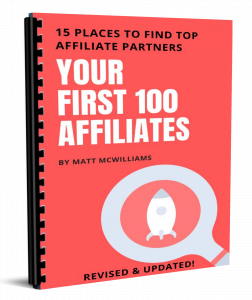 |
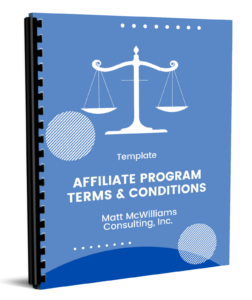 |
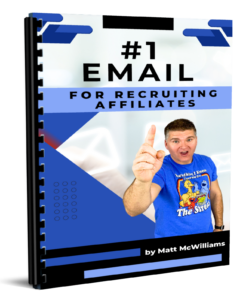 |
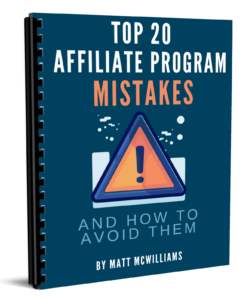 |
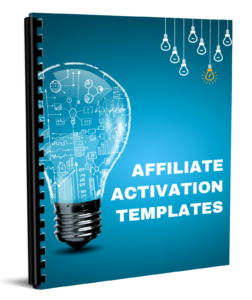 |
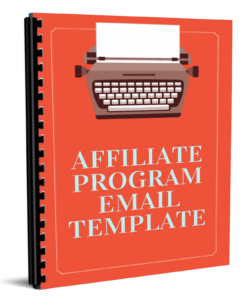 |
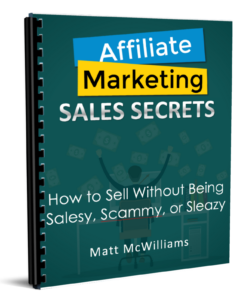 |
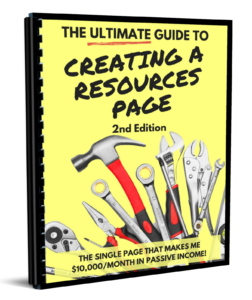 |
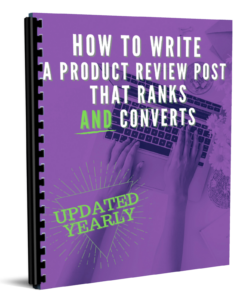 |
